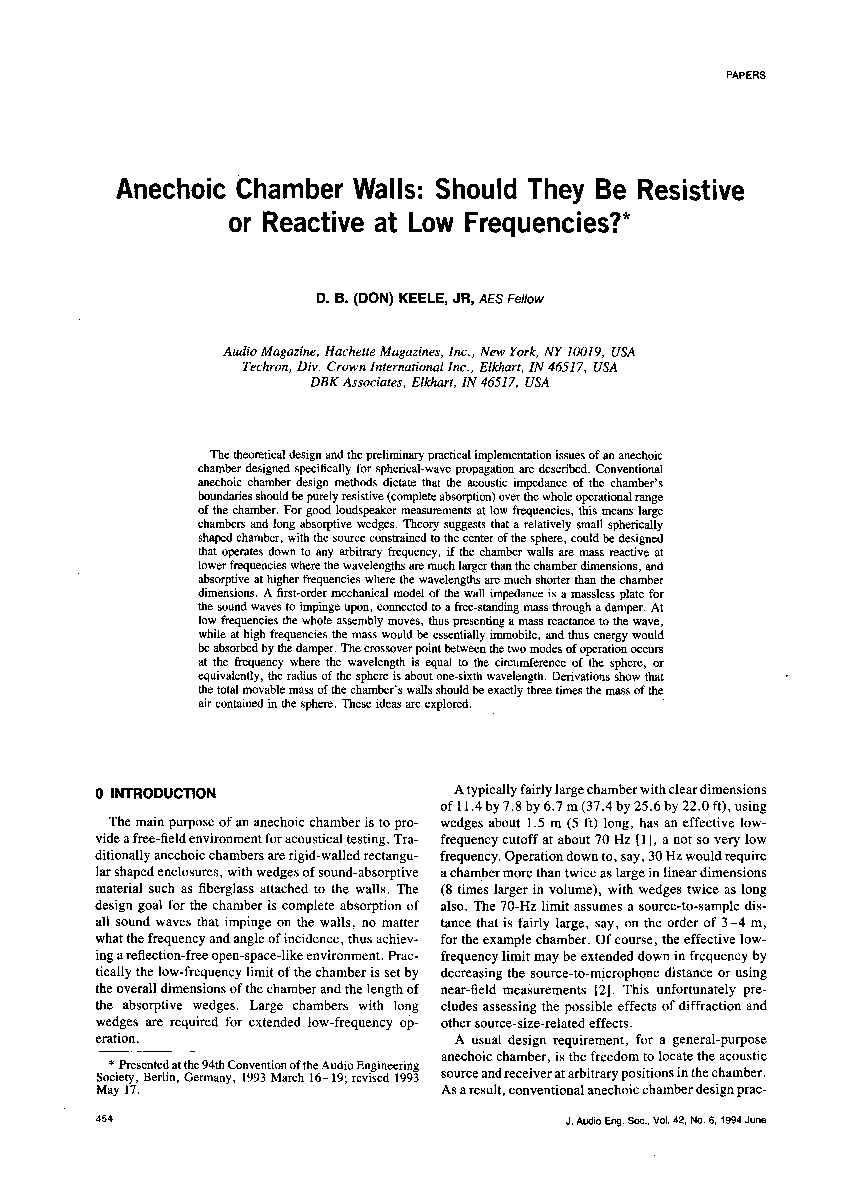Home / Publications / E-library page
You are currently logged in as an
Institutional Subscriber.
If you would like to logout,
please click on the button below.
Home / Publications / E-library page
Only AES members and Institutional Journal Subscribers can download
The theoretical design and the preliminary practical implementation issues of an anechoic chamber designed specifically for spherical-wave propagation are described. Conventional anechoic chamber design methods dictate that the acoustic impedance of the chamber`s boundaries should be purely resistive (complete absorption) over the whole operational range of the chamber. For good loudspeaker measurements at low frequencies, this means large chambers and long absorptive wedges. Theory suggests that a relatively small spherically shaped chamber, with the source constrained to the center of the sphere, could be designed that operates down to any arbitrary frequency, if the chamber walls are mass reactive at lower frequencies where the wavelengths are much larger than the chamber dimensions, and absorptive at higher frequencies where the wavelengths are much shorter than the chamber dimensions. A first-order mechanical model of the wall impedance is a massless plate for the sound waves to impinge upon, connected to a free-standing mass through a damper. At low frequencies the whole assembly moves, thus presenting a mass reactance to the wave, while at high frequencies the mass would be essentially immobile, and thus energy would be absorbed by the damper. The crossover point between the two modes of operation occurs at the frequency where the wavelength is equal to the circumference of the sphere, or equivalently, the radius of the sphere is about one-sixth wavelength. Derivations show that the total movable mass of the chamber`s walls should be exactly three times the mass of the air contained in the sphere. These ideas are explored.
Author (s): Keele, Jr., D. B. (Don)
Affiliation:
Audio Magazine, Hachette Magazines, Inc., New York, NY ; Techron, Div. Crown International Inc., Elkhart, IN ; DBK Associates, Elkhart, IN
(See document for exact affiliation information.)
Publication Date:
1994-06-06
Import into BibTeX
Permalink: https://aes2.org/publications/elibrary-page/?id=10277
(1682KB)
Click to purchase paper as a non-member or login as an AES member. If your company or school subscribes to the E-Library then switch to the institutional version. If you are not an AES member Join the AES. If you need to check your member status, login to the Member Portal.

Keele, Jr., D. B. (Don); 1994; Anechoic Chamber Walls: Should They Be Resistive or Reactive at Low Frequencies? [PDF]; Audio Magazine, Hachette Magazines, Inc., New York, NY ; Techron, Div. Crown International Inc., Elkhart, IN ; DBK Associates, Elkhart, IN; Paper ; Available from: https://aes2.org/publications/elibrary-page/?id=10277
Keele, Jr., D. B. (Don); Anechoic Chamber Walls: Should They Be Resistive or Reactive at Low Frequencies? [PDF]; Audio Magazine, Hachette Magazines, Inc., New York, NY ; Techron, Div. Crown International Inc., Elkhart, IN ; DBK Associates, Elkhart, IN; Paper ; 1994 Available: https://aes2.org/publications/elibrary-page/?id=10277